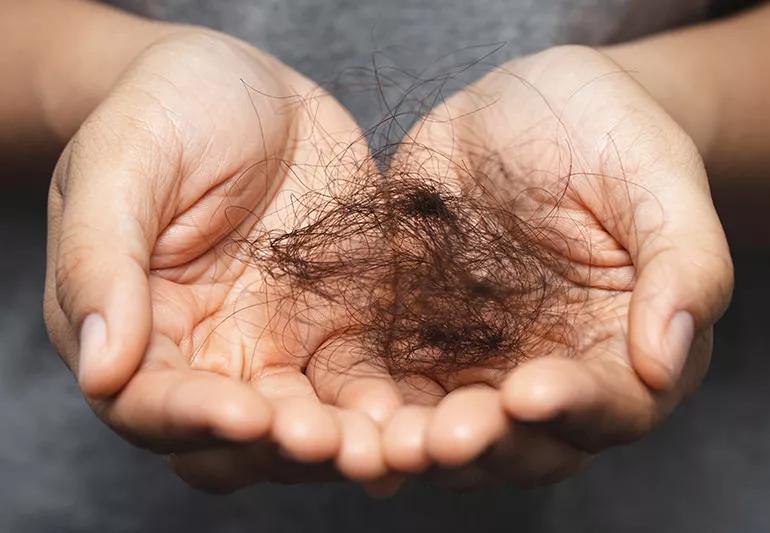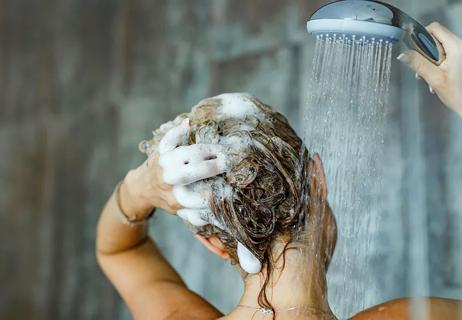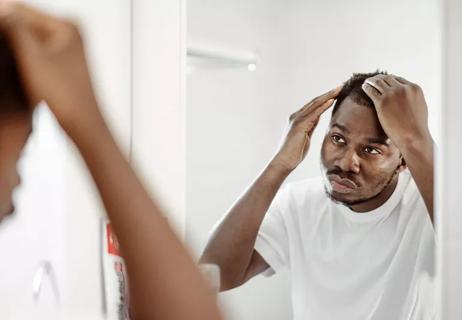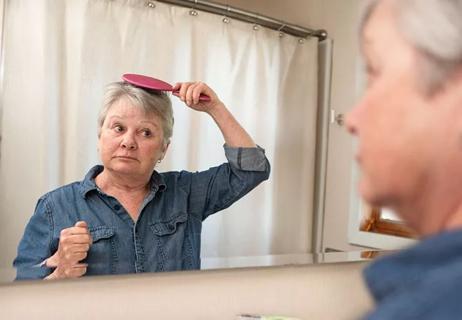This treatment can help those with cancer keep some of their hair

Hair loss is one of the top concerns for those undergoing chemotherapy for breast cancer. But a cooling cap may help some people keep their hair.
Advertisement
Cleveland Clinic is a non-profit academic medical center. Advertising on our site helps support our mission. We do not endorse non-Cleveland Clinic products or services. Policy
Hair loss related to cancer treatment is usually temporary. Most of the time, hair will grow back. But for many people, hair loss due to cancer treatment is a distressing event that is much more than a change in physical appearance.
Hair loss, also called alopecia, can be an emotionally challenging event that deeply affects your self-image and your daily life. A wig or a scarf marks you as a cancer patient and is a constant reminder of the disease.
Oncologist Megan Kruse, MD, discusses how cold capping works and what to expect.
Chemotherapy can cause hair loss by harming the cells that help hair grow. Hair follicles in the growth phase are sensitive to chemotherapy, resulting in hair loss about two weeks after treatment begins.
Cooling caps use intense cold to constrict the blood vessels in the scalp. That keeps the cell-killing chemo away from the hair follicles, where hair is produced.
“The whole idea is that when you expose the scalp to cold fluid, the blood vessels in the scalp clamp down,” says Dr. Kruse. “In doing so, less chemotherapy can be delivered through the blood vessels to where the hair follicles live.”
You’ll wear a cooling cap, which is a helmet-like device with circulating cooling fluid that cools the scalp to 36 degrees Fahrenheit (2 degrees Celsius). You’ll typically have to wear the cooling cap for 30 to 60 minutes before, during and after chemotherapy treatment.
Advertisement
Expect some hair loss, though. Dr. Kruse has seen individuals keep 50% to 70% of their hair, which is considered a success.
“Some people go in thinking they’re going to keep all of their hair and that it won’t look any different,” says Dr. Kruse. “But that’s not usually true. Typically, you’ll still have some hair loss and it can be more pronounced at the top or crown of your head.”
And you’ll need to decide about using a cold cap before your first treatment, says Dr. Kruse.
“The effects of chemo, in terms of hair loss, will set in after that first treatment,” she says.
So what should you expect when using a cold cap? You’ll notice the coldness of the cap and may experience some mild discomfort. It can also feel a bit constricting since the cap is a tight fit on your head and typically contains a strap that goes under your chin to keep it secure.
“It can also be tough for those who have a history of headaches or migraines,” Dr. Kruse says. “Some people will need to take an anti-inflammatory medication to help with some of the discomfort.”
There are two kinds of cold caps — and both have similar success rates.
The first kind of cold cap is customized for your head. The cap uses a hose to hook up to a machine that circulates cold water throughout the cap during treatment.
The other option uses multiple, often not fitted, caps. You’ll need to store them in a dry ice cooler and rotate the caps off and on throughout treatment. Since you’ll need to change caps often — typically every 15-30 minutes — Dr. Kruse suggests having someone with you during chemotherapy treatments to help.
Keep in mind that whichever method you choose, you’ll have to bring the cold capping equipment with you to each treatment.
“There’s a lot of patient responsibility with cold capping,” says Dr. Kruse.
Whether or not a cooling cap will work for you depends on the type of chemotherapy you receive. Doctors have seen success in those who are undergoing treatment for breast cancer and colon cancer.
“There are some chemotherapy treatments where the chemotherapy is so potent that if even a little bit gets up to those hair follicles, they’ll probably die off,” says Dr. Kruse.
Anthracyclines, for example, are a type of chemotherapy typically used to treat blood cancers like lymphomas and leukemias.
“With those medications, while you can have some hair that is kept by doing cold capping, it’s a much, much lower chance,” says Dr. Kruse. “It seems to be just because the medications are so strong.”
Advertisement
If cold capping sounds like a good option to you, discuss the treatment with your doctor to weigh the pros and cons. Another point to consider in your decision is how costly cold capping can be. Most insurances currently don’t cover cold capping.
“The big barrier really is insurance or lack of insurance,” says Dr. Kruse. “For most people, it is an out-of-pocket expense.”
You can expect to pay around $1,000 for cold capping throughout your course of chemotherapy.
But the psychological benefits of using a cold cap may prove worthwhile for many. Keeping most of your hair can have a positive impact when dealing with cancer.
“Women feel better about themselves. They feel more like themselves,” says Dr. Kruse. “They feel healthier in ways, and it can help normalize this experience for them.”
Advertisement
Learn more about our editorial process.
Advertisement

The endocrine gland in charge of hormone production may be causing your hair to shed or stop growing

They can’t treat the cause of your hair loss, but some ingredients are better than others

Illnesses can lead to hair loss, but it doesn’t last forever

How often you should do it depends on various factors

Keep your hair on your head with these tips

You can offset the effects of time, dyes and medications

The short answer from a dermatologist

The 411 on your shedding habit

Type 2 diabetes isn’t inevitable with these dietary changes

Applying a hot or cold compress can help with pain